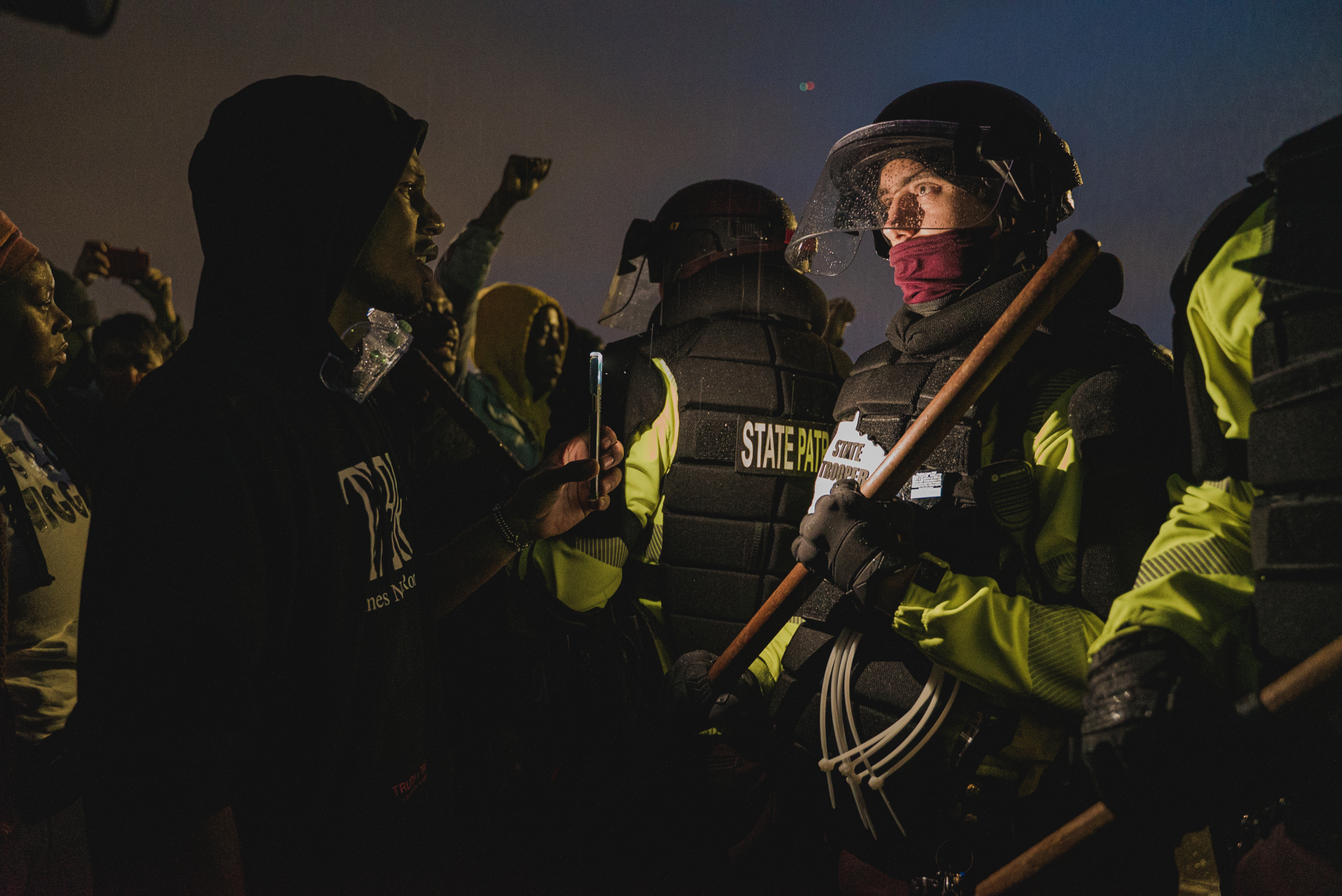Drew Arrieta, a photojournalist based in Saint Paul, Minnesota, described the tense moments he spent waiting to hear how the jury would rule on Derek Chauvin as “the most nervous hour ever.” Over the past year Arrieta, who is thirty-one, has spent considerable time at Black Lives Matter protests and related events on water protection, immigration rights, gun violence, and police reform and abolition. In that time, he has cultivated relationships with the organizers he documents and has shared in a commitment to keeping fellow community members safe. As a result, his photographs—tightly framed shots of Black women embracing, a curb cluttered with half gallons of milk and Gatorade—are stunningly intimate, as if from a family photo album. The images offer a careful, meditative depiction of his neighbors, what happened to them, and what they are doing about it.
Arrieta’s photography differs from many of the images I’d seen recently in national news outlets and wire services—even where they published searing, beautiful portraits of grief-fueled unrest, Arrieta’s shots seemed closer to earth. His work felt particularly powerful during the past few weeks, as I watched Chauvin, the white former Minneapolis police officer who murdered George Floyd, stand trial through the eyes of helicoptering reporters. Things intensified when, before the jury had reached a verdict, Kim Potter, a white police officer in nearby Brooklyn Center, Minnesota, shot and killed a twenty-year-old Black man named Daunte Wright, a father, at a traffic stop. (Wright had been pulled over for expired registration tags.) Potter, an officer for twenty-six years, claimed that she had mistaken her gun for her Taser. It goes without saying that we had been there before—and indeed, even as Arrieta awaited word on Chauvin’s case, there we remained.
Arrieta, who was born in Brooklyn and raised in Queens, arrived in Saint Paul about four years ago; he’d relocated for his job, at Effect Partners, where he works in social impact consulting, mostly on campaigns related to climate change. (His current focus is the availability of plant-based food in oppressed communities.) At the time, he was taking photos as a hobby, using a basic point-and-shoot camera. But after Floyd’s murder, he began to delve into journalistic work.
“It started from a place of just documenting what was going on,” Arrieta said. As he shot, he noticed journalists coming in and out of town. “I realized that this parachute style of journalism exists, especially as the Twin Cities has become the epicenter for the largest racial justice movement in America.” Their efforts often seemed to amount only to a prelude. “I’ve been on the ground, intimately knowing the facets of this movement—from those who want to abolish police to those who want community control to those who want to reform to individuals who have lost loved ones,” he explained. “There’s a lot of distrust in media and press overall because of that parachute style of journalism. And a lot of people I connect with don’t feel journalists are invested enough in the story, that they’re looking for headlines or the sensational photo.”
After Wright’s death, Arrieta went to Brooklyn Center to document the demonstrations calling for accountability. Law enforcement, dressed in riot gear, met protesters with aggression, using rubber bullets and chemical irritants. At one point Arrieta was hit in the face with a rubber munition. His vision went white, and he stumbled backwards, unable to see. But soon he had help: frontline activists recognized him and came to his aid. Arrieta told me this was common, in his experience; in recent months he’d received lots of help from people on the ground. Most of his gear was donated by members of the communities he shoots—including his combat helmet, protective goggles, and bulletproof vest. His camera is on loan from Ben Solomon, formerly of the New York Times.
“I don’t put calls out for funds, but they ask if I need supplies,” Arrieta said. “People have Venmoed me money; other bipoc photojournalists have donated money to me to make sure I’m protected. I’ve had people deliver food for me, Reiki therapy sessions, and deliver plants.” He’s appreciated the support. “This work has been extremely challenging to my physical and mental health,” he explained. The shot to his face by police in Brooklyn Center had given him a minor concussion. “It’s challenging, and I haven’t received any monetary returns or riches, but that’s not my guiding compass,” he told me. “There’s a major need in storytelling to provide a more bottom-up perspective.”
When, at last, Chauvin was declared guilty of all charges, Arrieta was outside the courthouse, alongside a thousand others. “People were waving flags outside their cars, a lot of celebrations,” he said. Afterward, he went to George Floyd Square—near Cup Foods, where Floyd took his last breath—camera in hand. “There’s a lot of people who immediately shared photos and videos. But there was such a spectrum of emotions, from confusion to happiness to joy to people crying,” he told me. “People feeling as if this wasn’t justice, just accountability, and that there’s a lot more to be done, and no reason to be celebrating, because this was the bare minimum required.” He documented the scene, then went home to sit with what he’d witnessed. “I want to cover all those nuances of the movement, of this moment,” he explained. “It wasn’t just joy. There was sadness. There was anxiety. People are still grieving for other loved ones.”
Arrieta shared with me a series of photos he’s shot in the Minneapolis area and in Washington, DC, over the past several months, chronicling the movements to eradicate racial oppression in the United States. What follows is his description of the images.
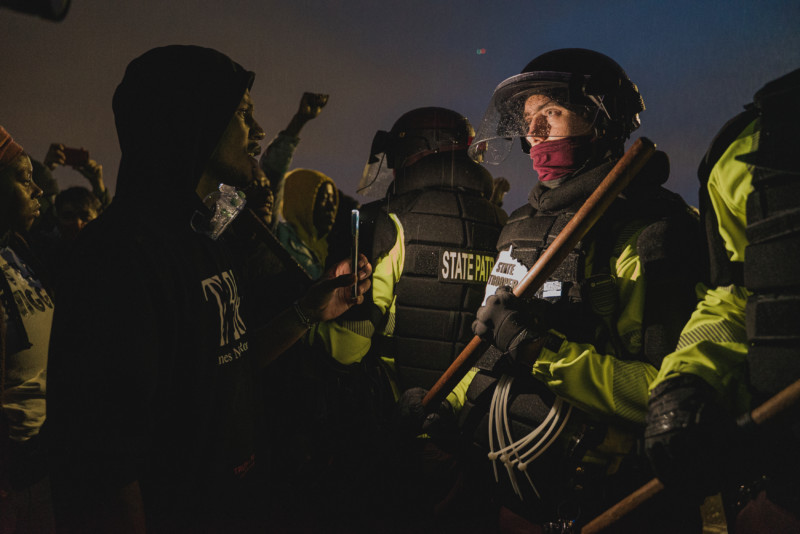
Protester trying to engage in a conversation with a Minnesota state trooper near the Brooklyn Center police department on April 12, 2021. Photo by Drew Arrieta
There’s a church by the Brooklyn Center Police Department, and a line was being created by state troopers. What I found to be really interesting was that a lot of communities that consider themselves victims of police violence, like Black Americans and brown people, really use it as an opportunity, like therapy sessions, where they try to get troopers to renounce police violence. And the police are completely silent; they don’t respond, or they’ll lock eyes with the people having conversations with them. It’s very intense. I caught this moment where a young Black man is trying to have a conversation with a state trooper who is shining a light in his eyes. He’s saying how he feels scared, and the trooper isn’t doing anything but gazing intently back into his eyes. This happens very often in Minneapolis and other cities. It sort of exemplifies a larger theme that a lot of Black Americans feel when they’re trying to communicate with law enforcement—the feeling of not being heard. I’ve always wondered, What would it be like if an actual conversation started, if there was actually dialogue there? I feel like there’s something larger here that’s representative of a lot of people feeling unheard when they speak out about police violence, particularly when there’s someone trying to have a conversation with someone they deem as an oppressor. I never shoot with flash. I tried to use the lampposts, people using their flashlights; very often, I use the flash of other photographers’ cameras when it comes to lighting. It was raining and the rain was falling on the plastic shield. He had that constant look, eye level, looking directly, a very forceful gaze. No other emotions. There are protesters out there cracking jokes about police, and you’ll sometimes see officers react, but this trooper kept his gaze and was unmoved by anything that was said to him and didn’t reply back at all. He was just there, frozen.
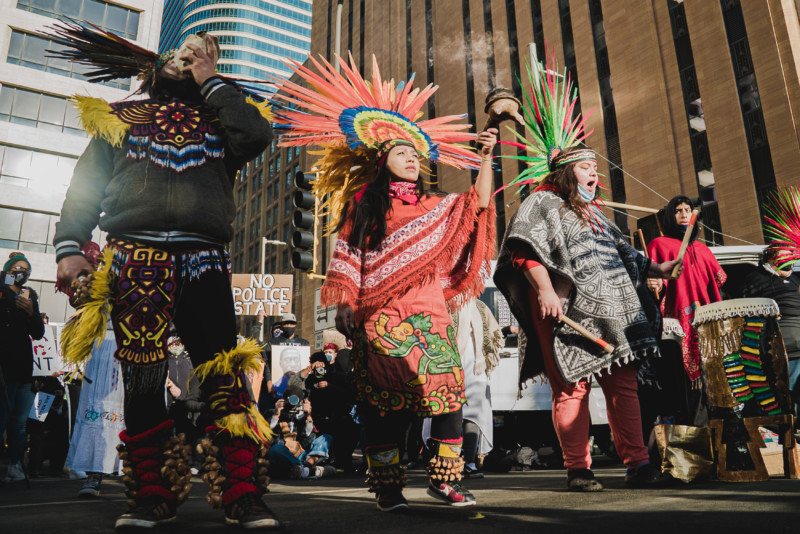
Kalpulli Yaocenoxtli, an Aztec dance group, during a rally outside the Hennepin county courthouse during the Derek Chauvin trial, March 8, 2021. Photo by Drew Arrieta
Kalpulli Yaocenoxtli is an Aztec dance group that’s a mainstay at any march around police violence or state violence. They’re a dance group that is a collection of different individuals from Latin America, the Caribbean, and Spanish-speaking countries. They perform Indigenous music and dances, typically at the beginning of a protest, but they also march along the route. I’ve seen them doing a dance for five-to-ten-mile marches around the Twin Cities. They’ve also done a really incredible job of interconnecting a lot of the struggles that oppressed individuals in Minnesota have felt, by connecting immigration with police brutality, but also creating a space for dance and celebration and ritual. They’ve been a dance troupe since 2007, and they’ve been very active in the movement-building that has been part of the Twin Cities from Philando Castile to Jamar Clark and others killed by police in Minnesota. I’m familiar with their dance style; I know where to set up and position myself. At a lot of events and rallies, I know the routing of the march before the march begins. So that allows me to position myself in interesting places, and I also get a bit closer to a lot of the dancers. They typically form a circle and the drummer is in the middle. I’m allowed to get really close in on their faces. Other photojournalists have gotten in trouble for it or been told to please back up. Me knowing them personally—I’ve been to their gallery. I’ve documented some of their openings. They have given me a tour of their space, and they’ve been really generous and kind to me. I understand their work and respect it and how much effort and time—from being outside in freezing cold to the hot, sweaty summer, they’re always there. They appreciate others who show that commitment as well.
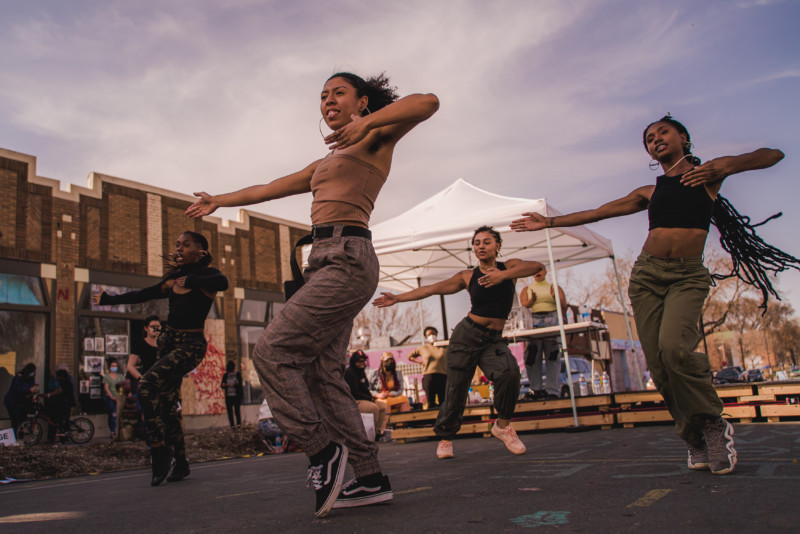
New Black City performing at the People’s Fest in George Floyd Square on April 4, 2021. Photo by Drew Arrieta
It’s really important to capture all facets of this movement—not just trauma, but joy, resilience, celebrations. New Black City is an all bipoc, femme, nonbinary, trans dance troupe that performs throughout the Twin Cities. This was taken at People’s Power Love Fest at George Floyd Square. People’s Fest was gathering signatures to get specific language about community control of police on the ballot in November. They do such an incredible job of creating a safe space for Black, brown, bipoc bodies of all shapes and sizes and genders and identities to dance and have fun. When you think about social movements overall, you think about tension, aggression, trauma. But there’s also a lot of joy and resilience. George Floyd Square has become this safe space for that type of community-building that didn’t really exist elsewhere. There’s definitely been organizations and galleries or community spaces, but now there is an intersection that is representative of the reasons that brought everyone there, a space for people, maybe not a part of the movement, to come visit. There’s certainly tourists coming by to stop to visit, but also a lot of people who don’t consider themselves activists, don’t consider themselves part of the movement, or who are not necessarily putting up Black Lives Matter signs outside their home, but will come visit George Floyd Square and, while there, get to see another side of this moment that isn’t typically portrayed.
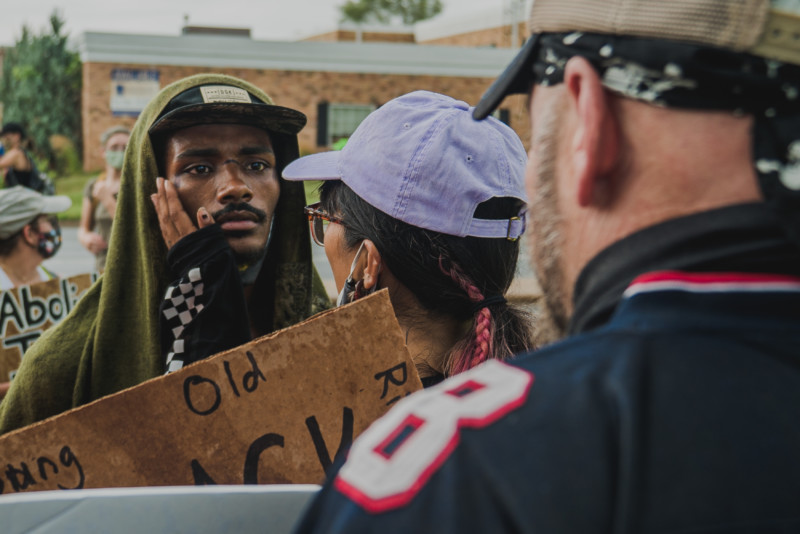
A Black Lives Matter protester locks eyes with a Blue Lives Matter supporter at the Bloomington March for Justice on July 25, 2020. Photo by Drew Arrieta
The Twin Cities are historically liberal and vote Democrat, but the suburbs lean Republican and conservative. Throughout the summer, there would be Blue Lives Matter rallies at the same exact time that there were Black Lives Matter rallies. These were always very delicate, highly intense situations. At this one, there was a Black Lives Matter rally starting at a school three blocks away from a library that was hosting a Blue Lives Matter rally. It started to pour this awful rain—and thunderstorm—the moment we were meeting the Blue Lives Matter rally. A shouting match began. A lot of the Blue Lives and pro-Trump crowd carry semiautomatic weapons and they make sure folks know. The man who is directly in front of the camera, wearing the number eight on his shoulder, was a Blue Lives Matter supporter talking about how “All lives matter” and not only Black lives. He was yelling, saying Black Lives Matter is a terrorist movement, calling them “antifa.” The term folks use is trolling. He was antagonizing this individual into some level of altercation. He wanted him to get angry, to rile him up. This individual’s name is Tino, and he just positioned himself as fearless, not scared of this man and what he was saying. His partner holding his face was letting him know, You don’t wanna get into an altercation, it’s not worth it. Tino wanted to show he was willing to stand up for himself. There’s also police there on the scene, standing on the side, not getting involved at all. This is one of a couple photos I have where people are trying to de-escalate.
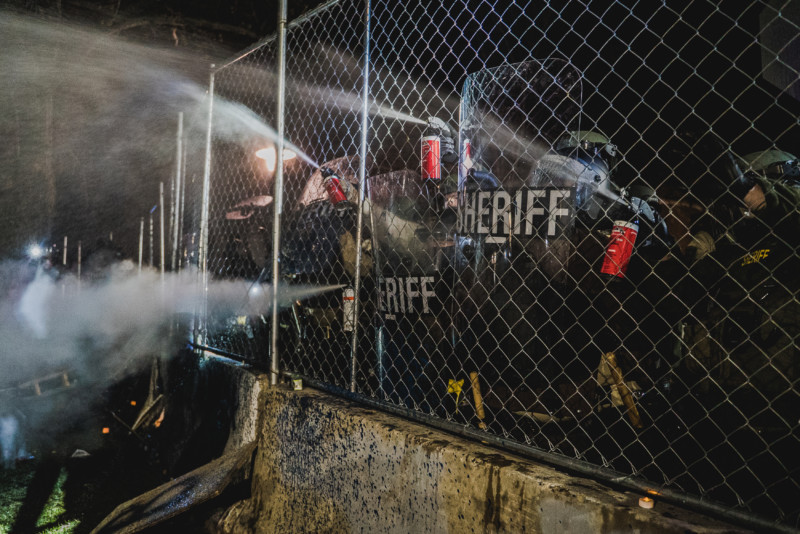
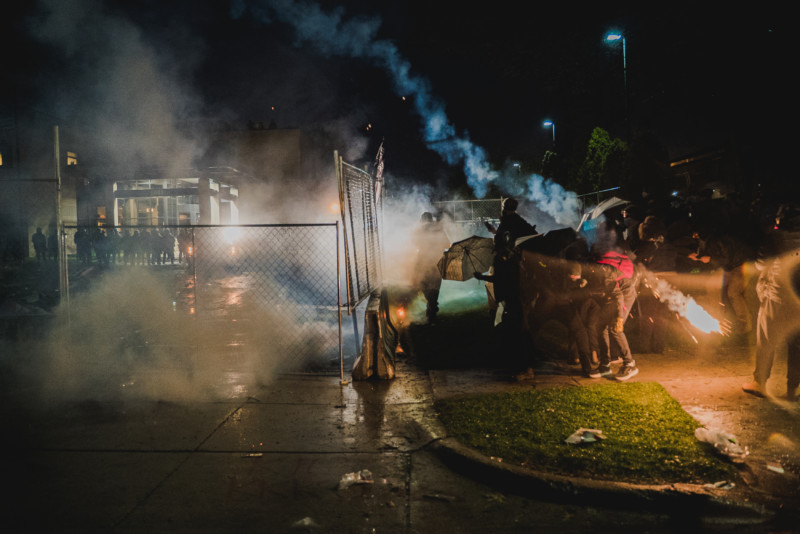
Law enforcement officers deploy flash bangs and tear gas to disperse a crowd outside the Brooklyn Center police department the week of April 12, 2021. Photos by Drew Arrieta
This was when the tactics of the law enforcement officers were a bit more violent and aggressive. In the first photo, you can see four different pepper spray canisters being sprayed on a crowd directly in front of them. The second photo is tear gas and a flash-bang being used. I really wanted to show the level of aggressiveness versus a bunch of people just holding umbrellas as makeshift shields. They’re not on the same level in terms of intensity. Especially in the second photo, it really shows the officers positioned very far back from the gate where people are located. Officers were shooting rubber bullets and tear gas off the roof of the building at individuals who were largely peaceful. Through the week, some nights, the police would back off and not do anything, and allow people to hold space there, and there wouldn’t be any violence. But whenever tear gas, pepper spray, or rubber bullets were used, it would escalate the situation and get people angry—and give them additional reason to come back. It wouldn’t deter the people, it would cause them to double down. The people holding space there are protesting against police violence and brutality and, at the same time, that’s exactly how police are reacting, only compounding the narrative. I was hit in the head and had to deal with a ringing headache throughout the week. A lot of it was—this is my personal opinion—largely unnecessary. On nights when chemical irritants were not used, people were allowed to be there and then they went home. There’s something to be said about giving people space to grieve and come together. I think that’s the importance of George Floyd Square in de-escalating a lot of the unrest that was happening in the city. When that space is interrupted by violence, especially by police, it only escalates and enrages individuals more, and they come back the day after stronger.
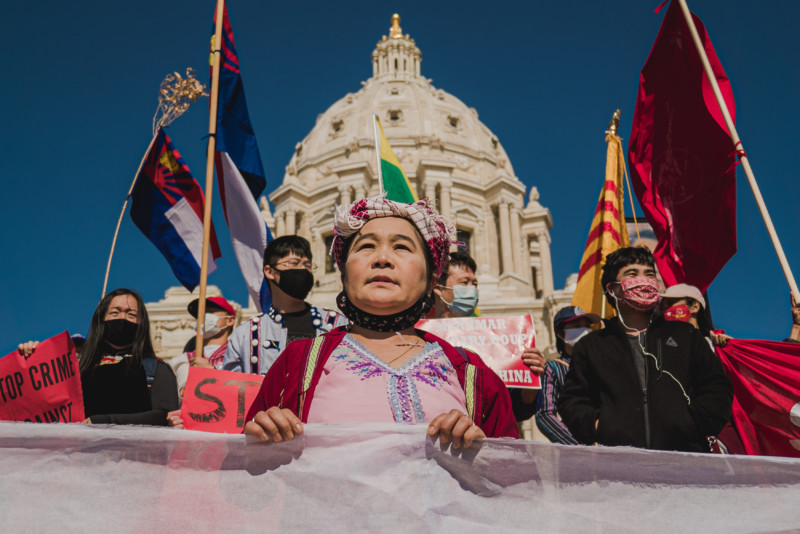
A crowd stands in front of the Minnesota state capitol demanding an end to the military coup in Myanmar, on March 12, 2021. Photo by Drew Arrieta
This is a rally that occurred outside the Minnesota state capitol, around the military coup occurring in Myanmar. Since the uprising and Black Lives Matter in Minnesota, there’s also been a recharge, or an ignition, of other solidarity movements of other communities in Minnesota that aren’t typically outspoken and don’t have a presence among protesters occupying streets and rallying. The Burmese community in Minnesota is fairly small, but I think they are pulling from the energy of Black Lives Matter that exists here. There’s also the Oromo community, an ethnic group based in Ethiopia, that has started holding rallies and marches very similar in style, even the chants, to the Black Lives Matter movement. This was around the time the country’s prime minister began jailing political opponents, especially those from the Oromo community. It was essentially ethnic genocide, so the community here in Minnesota started to stand up and demand accountability from the US government, saying that their lives matter, using similar language to the Black Lives Matter movement. It was the same for this Myanmar event, where individuals not typically a part of the social political activist landscape in Minnesota were taking space and demanding more from American leadership and leadership abroad. It’s been interesting to see these movements cross-pollinate. A lot of the youth activists from the Burmese rally were standing with protesters in Brooklyn Center last week, and the same with the Oromo community.
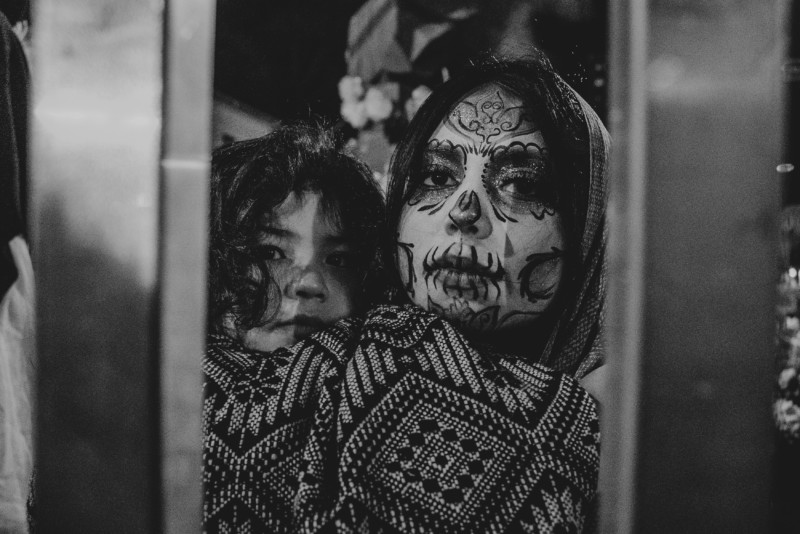
A woman wearing Día de los Muertos makeup holds a small child behind a steel frame at George Floyd Square on November 1, 2020. Photo by Drew Arrieta
There was a Día de los Muertos event at George Floyd Square. It’s a holiday immortalizing and praying for people who have passed away—and, for this event, folks killed due to police violence from across Minnesota. People were dressed up, and there were these steel benches that were placed upright. It was at this moment when there was a lot of anxiety and witnessing of kids in cages, and how immigrants, especially those from Latin America who were coming through Mexico, were being treated at border facilities. This photo, for me, creates a sort of caged effect using that bench. I use this photo to bring light to the disasters happening at our detention facilities. As of October 2020, there were five hundred migrant children unable to reunite with their parents after being separated at the border. This photo is representative of that, and in the background you can faintly see a fist at George Floyd Square. I think it’s important to show that everyone, from the families demanding more at the border to the Myanmar community—they’re all people who are raising their hand right now and saying, We are unable to live a thriving, equitable life. And we need more.
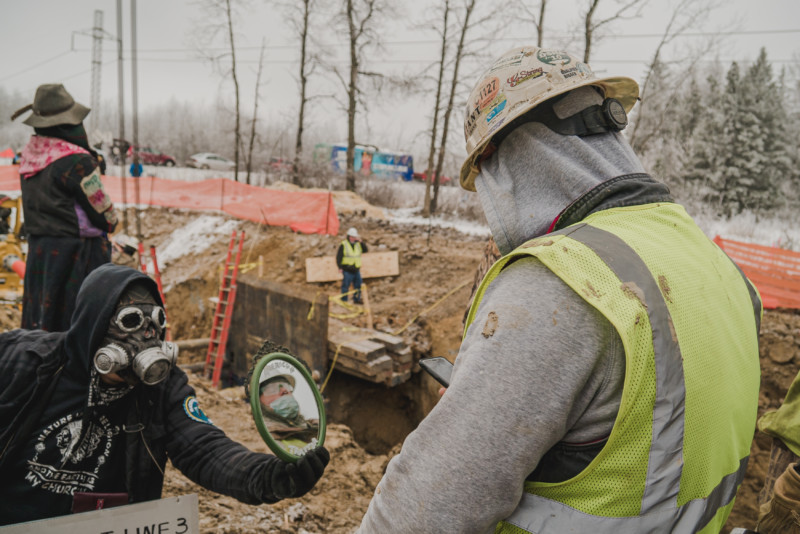
A man holds up a mirror to an Enbridge Inc. employee working on a replacement pipeline for Line 3 in Aitkin County, Minnesota, January 9, 2021. Photo by Drew Arrieta
This is an action where a caravan of water protectors popped up at a construction site for the Line Three pipeline, and one had this mirror that said “American traitor” and was putting it in the face of a lot of the construction workers. This movement itself has been largely led by the Indigenous community that is based in north Minnesota and have been consistently trying to slow down construction. The governor is supportive of the site, and rural Minnesota, where this pipeline is being built, is very economically depressed. This is probably the biggest job creation in Palisade, Minnesota, and the surrounding area. Even though this is about four hours away from the Twin Cities, a lot of Line Three activists are constantly down in the Twin Cities supporting Brooklyn Center, trying to help pass police accountability bills.
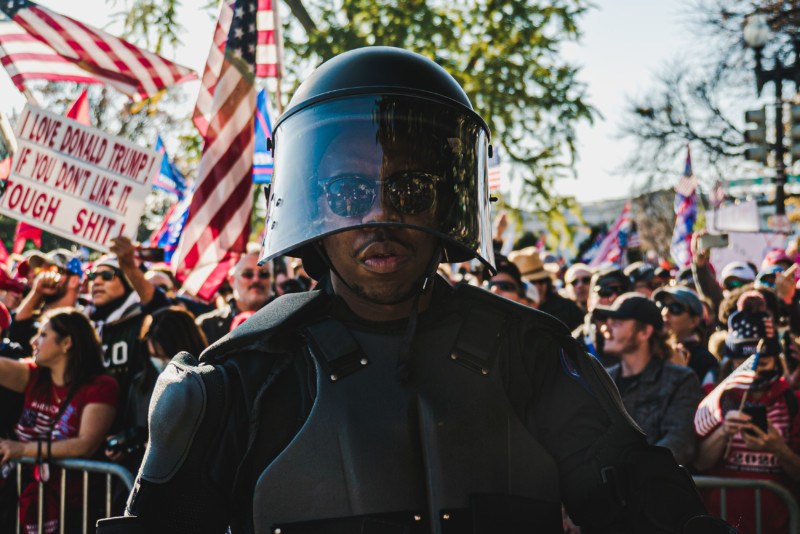
A Washington, DC, police officer in riot gear facing Black Lives Matter protesters during a Million MAGA March at the Supreme Court on November 14, 2020. Photo by Drew Arrieta
After the election, I was honestly expecting something similar to what happened January 6 to happen, so I decided to go to DC for a couple days. It was very telling. This event itself scarred me from going back to DC again. It was about fifty thousand Trump supporters who didn’t believe in the election results. Anyone who was a member of the media, or of a small opposing faction of protesters, were treated as enemies of the state. When I was covering this, I had food thrown at me, I had seven or eight people threaten to “beat the shit out of me,” explicitly using those words. Everything from a twelve-year-old boy to a thirty-year-old white man to a sixty-year-old woman threatening to fight me. I had someone toss a bike in my direction to hit me. I had lots of individuals pointing at me and using the white power hand sign that the Anti-Defamation League has considered a hate sign. It was a really scarring event. What was fascinating was the moment that riot police showed up and formed a line in front of a small group of press and Black Lives Matter protesters, while we received death threats and things were hurled at us and white power hand signals were being pointed at individuals of color. This photo really struck me. This Black male, he was a DC police officer wearing the Malcolm X iconic sunglasses, standing in front of these Trump supporters. It has stayed with me. One thing that has been alarming covering Trump rallies in Minnesota and DC was that the Black Lives Matter supporters were treated as the agitators and violent threat. Behind this man is tens of thousands of Trump supporters yelling heinous things at a small group of people, but the riot police are facing us. In 2020, I was threatened by more men with semiautomatic weapons than I ever imagined. I felt like I lost a piece of my humanity. It was terrifying, and I feel like it’s something I’m still working through. The only reason I felt safe out there was because the frontline activists from DC looked out for me. The presence of the police didn’t make me feel safe. It only terrified me. Even now, at Brooklyn Center, when police with riot gear show up, in my head, they’re there to brutalize people; they aren’t there to protect. That was the scene I witnessed. This moment has changed my relationship with police overall; I think my subconsciousness has changed. Just the sight of them, it’s different.
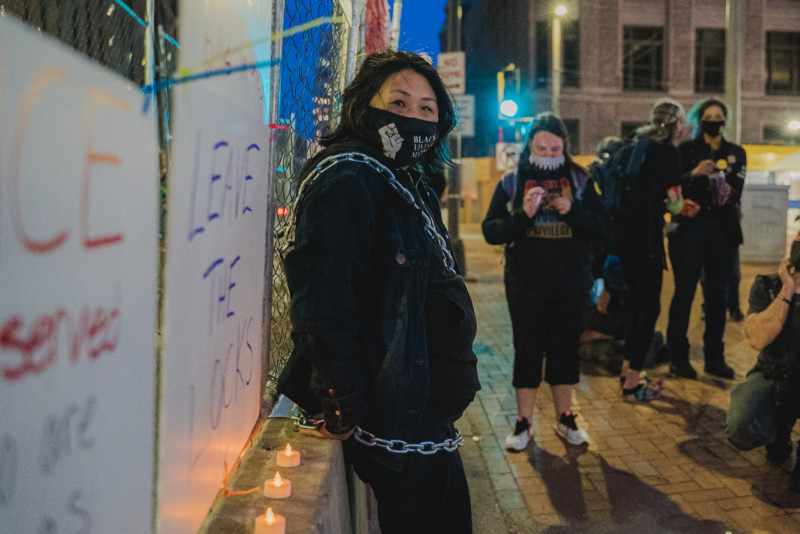
Kaia Hirt chains herself to a barbed-wire gate outside the Hennepin county courthouse to demand that Minnesota legislators pass police accountability legislation on March 29, 2021. Photo by Drew Arrieta
I’ve been fascinated by people who decided to join the movement, who didn’t consider themselves activists before. Kaia Hirt chained herself to a fence outside the Hennepin County courthouse. Kaia is like, a middle school teacher in a suburb in Minnesota who wasn’t involved until Floyd’s murder, when she started to hear stories from families who have lost loved ones to police violence. She is just like, a middle school teacher, very warm and kind, and she took this militant stance. She swapped out with someone after two days.
Editor’s Note: This story has been updated to correctly identify Arrieta’s employer.
Alexandria Neason was CJR’s staff writer and Senior Delacorte Fellow. Recently, she became an editor and producer at WNYC’s Radiolab.



